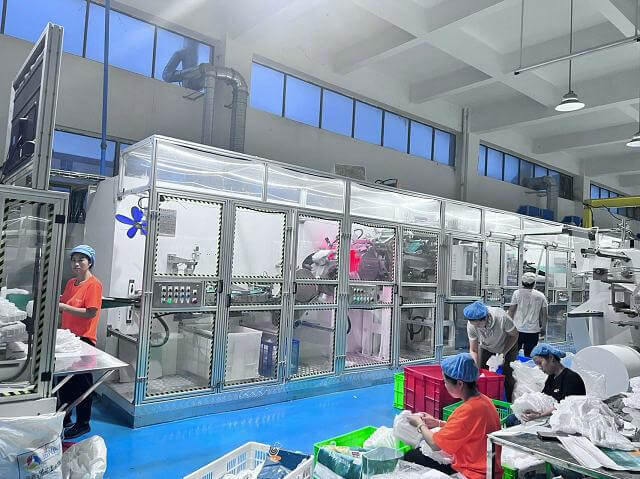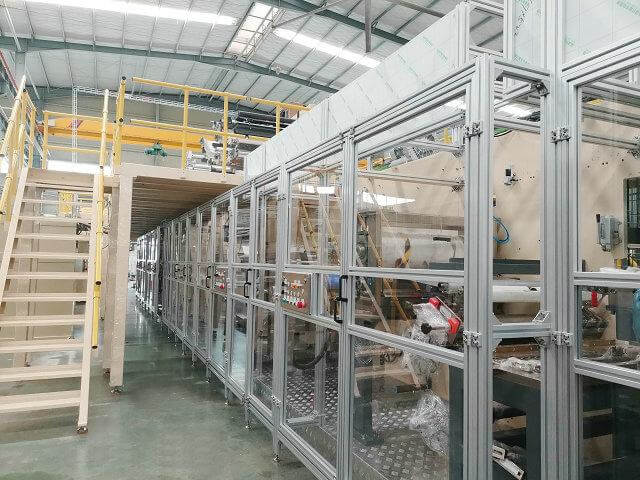Author:Haina Machinery Factory FROM:Diaper Machinery Manufacturer TIME:2023-12-20
Operating Guide for Female Diaper Manufacturing Machine
The female diaper manufacturing machine is a vital piece of equipment used in the production of high-quality diapers for women. This operating guide aims to provide a comprehensive overview of the machine's functionalities, maintenance requirements, and safety precautions. By following this guide, operators will be able to maximize productivity, reduce downtime, and ensure the consistent production of superior diapers.

Before operating the female diaper manufacturing machine, it is essential to ensure proper setup. This includes checking for any loose parts, adjusting the tension of belts and chains, and verifying that all connections are secure. It is also crucial to lubricate the moving parts regularly to prevent friction and ensure smooth operation.
To produce high-quality female diapers, it is necessary to prepare the materials correctly. This involves selecting the appropriate absorbent core, elastic bands, and nonwoven fabrics. Operators should ensure that the materials are stored in a clean and dry environment, free from dust and moisture. Additionally, the machine should be calibrated to handle the specific dimensions and thicknesses of the chosen materials.
Operating the female diaper manufacturing machine requires careful attention to detail. Operators should familiarize themselves with the machine's control panel, which allows them to set parameters such as production speed, tension, and cutting lengths. It is important to monitor the machine closely during operation, addr

Regular maintenance and cleaning are crucial to keep the female diaper manufacturing machine in optimal condition. This includes checking and replacing worn-out parts, inspecting and tightening connections, and removing any debris or accumulated waste. Lubrication of moving parts should be performed according to the manufacturer's recommendations. It is also important to clean the machine at regular intervals to prevent contamination and ensure hygienic production.
Operating any machinery involves inherent risks, and the female diaper manufacturing machine is no exception. Operators should receive proper training on safety procedures and wear appropriate personal protective equipment (PPE). It is crucial

Inevitably, issues may arise during the operation of the female diaper manufacturing machine. Having a troubleshooting guide on hand can help operators identify and rectify common problems quickly. This guide should include step-by-step instructions for addressing issues such as jams, misalignments, or irregular cutting. By promptly addressing these problems, operators can minimize downtime and maintain productivity.
Producing high-quality female diapers requires stringent quality control measures. Operators should regularly inspect the final products for defects such as loose elastic, improper adhesion, or inconsistent sizing. Samples should be taken at regular intervals and tested for absorbency, strength, and overall performance. Any deviations from quality standards should be documented and analyzed to identify potential causes and implement corrective actions.
To stay competitive in the market, it is vital to strive for continuous improvement in the manufacturing process. Operators should actively seek feedback from end-users and analyze customer complaints or suggestions. This information can be used to identify areas for improvement, whether in terms of product design, materials selection, or production efficiency. Regular training and skill development programs should also be implemented to enhance operator knowledge and expertise.
The proper operation of the female diaper manufacturing machine is essential to ensure the production of high-quality diapers for women. By following this operating guide, operators can maximize productivity, maintain product consistency, and adhere to stringent quality control standards. Continuous monitoring, maintenance, and improvement will contribute to the long-term success of the manufacturing process, ultimately benefiting both the manufacturer and the end-users.
